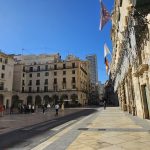The Guardamar Town Hall’s special plan to regulate Campo’s well-known Sunday market, which was started in 1993 on non-urbanizable land and includes a portion of the Natural Park of the Lagoons of Torrevieja and La Mata’s Natural Resources Management Plan, has received a negative opinion from the Generalitat.
The environmental assessment committee signed the resolution over a year and a half ago, but the General Directorate of Urban Planning of the Generalitat has only just mandated its public release.
The market’s owners and the Association of Vendors of Campo de Guardamar have both filed appeals, but the administrative judgement jeopardises the activity’s continued existence.
According to the study, the special plan is deemed unfeasible in light of the local characteristics and has a substantial environmental impact.
The Generalitat specifically raises concerns about the lack of clarity in the resolution of the activity’s impact on traffic congestion and the disregard for the rules of the Sectorial Plan for Commerce of the Community (Patsecova) and the Territorial Action Plan against the Risk of Flooding (Patricova). Despite being outside the Natural Park’s boundaries according to the special municipal plan, the technicians’ reports—particularly those of the protected area’s director of conservation—show that a portion of the ongoing activity does have an impact on the Natural Resources Management Plan strip. Because the actual activity that happens on the ground every Sunday is far larger than the municipal proposal that is displayed on the surface.
The group of sellers, the landowner who oversees it, and sources from the City Council’s own governing team have explained that the precautionary measures taken by the court that decides whether the installation is legal are still in effect even though the allegations in the unfavourable report that was sent to those impacted in mid-2023 have not been addressed.
After an appeal, the court declared that it would not rule on the matter and that these precautionary measures would be maintained with authorisation to open until the regional administration determined whether the special plan would allow their legalisation, in response to a 2015 TSJCV ruling ordering the closure.
In 2021, the City Council presented a specific plan for “a private provision of a tourist street market with complementary public use” for sporting and cultural events. There are also public initiatives aimed at protecting the activity. Another municipal special plan was started in 2014, however it was archived in 2016 after suffering the same fate.
Three prior attempts to get a declaration of community interest, an urban planning tool that would have also permitted the activity to be legalised, were denied between 1993 and 2013. The facility’s closure would have a severe financial impact on dozens of families, according to those impacted. In the peak season, up to 600 companies open on Sundays, and in the winter, at least 450.
About 27,000 square meters make up the market and the parking lot. It offers the typical market fare, which includes fresh produce, clothing, and fruits. In this instance, however, it is accompanied by a showcase of over 60 eateries featuring kitchens and terraces. In addition to finding a wide range of services like cable television, home furnishings, and even real estate, thousands of visitors wind down their Sunday mornings with lunch.
The same sellers have been using the permanent installations for decades; many of them utilise this location for their primary weekly sale because weekend markets are far more popular than conventional ones. In addition to purchasing supplies, users come here for leisure and entertainment.
José Cánovas, a businessman, notes that the Association of Vendors and the management are prepared to invest the required funds to carry out the special plan. They are also willing to give up the use of the land for public events and build a roundabout on CV-895 to give access to the Los Curros path, which is where the market is located.
The same source questions how the Administration could have permitted a development like El Raso, “with houses on the shore of the La Mata lagoon,” while refusing to permit the market. This is a reference to a contentious one-million-square-meter development that, following a protracted legal battle, one of the primary advocates of Vega Baja was able to remove from the Natural Park’s highest protected area.
With thousands of tourist-residential homes that are primarily drawn by the views of the protected lagoon, the last stage of building is currently under way. Additionally, according to the same sources, commercial activity was in operation long before the Plan de Ordenación de Recursos Naturales was approved in 2010, and the regional administration rejected a specific request to remove it from that area.
Another sizable, private market is being hosted next to the N-332, across from the Santa Ana industrial complex, in addition to this Sunday market in Guardamar.









No Comment! Be the first one.